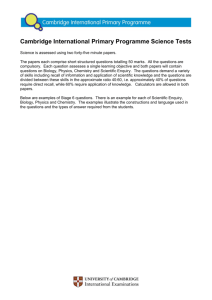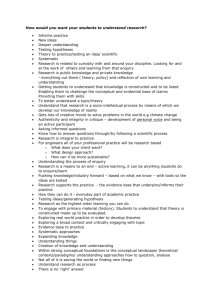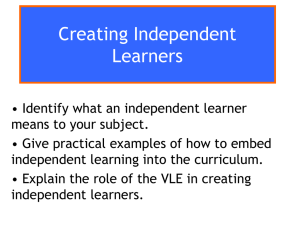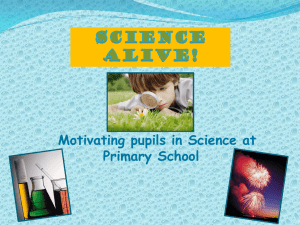Annual plan updated - Grades 5, 6 and 7
advertisement
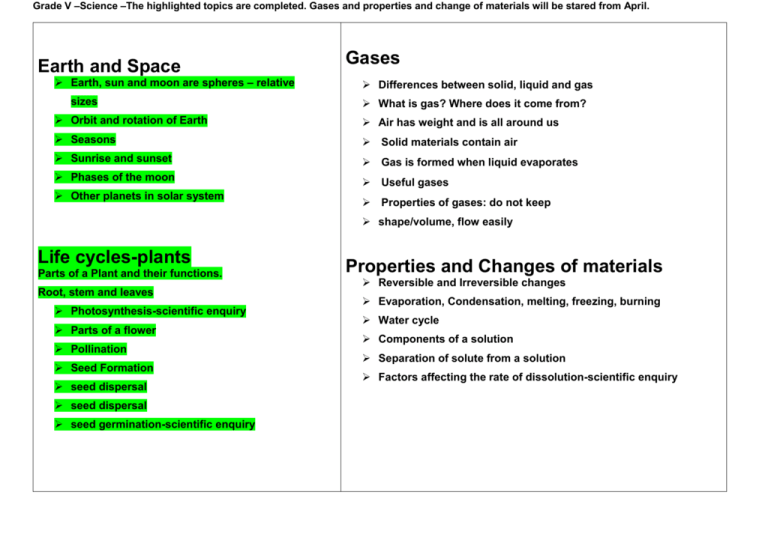
Grade V –Science –The highlighted topics are completed. Gases and properties and change of materials will be stared from April. Earth and Space Earth, sun and moon are spheres – relative sizes Gases Differences between solid, liquid and gas What is gas? Where does it come from? Orbit and rotation of Earth Air has weight and is all around us Seasons Solid materials contain air Sunrise and sunset Gas is formed when liquid evaporates Phases of the moon Useful gases Other planets in solar system Properties of gases: do not keep shape/volume, flow easily Life cycles-plants Parts of a Plant and their functions. Root, stem and leaves Photosynthesis-scientific enquiry Parts of a flower Pollination Seed Formation seed dispersal seed dispersal seed germination-scientific enquiry Properties and Changes of materials Reversible and Irreversible changes Evaporation, Condensation, melting, freezing, burning Water cycle Components of a solution Separation of solute from a solution Factors affecting the rate of dissolution-scientific enquiry Grade VI–Science –The highlighted topics are completed. Light-Seeing things and changing Circuits will be stared from April. Changes of Materials Reversible and Irreversible changes Evaporation, Condensation, melting, freezing, burning Water cycle Light –Seeing things Light travels from a source Light from a source enters our eyes Components of a solution Mirrors reflect light Separation of solute from a solution Beams change direction when Factors affecting the rate of dissolution-scientific enquiry Microorganisms What are microbes reflected from surfaces Shiny surfaces reflect better Microbes cause decay Microbes are used in food production Identify and name the main parts of the human circulatory system describe the functions of the heart, blood vessels and blood Recognise the impacts of diet, exercise, drugs and life style on the way their body functions. Shadows and reflections are different Edward Jenner Microbes cause illness Animals including humans Changing Circuits Complete circuit needed to make bulb or motor work Bulb brightness, wires or motor speed can be changed in a circuit and affect output Conductors and insulators Symbols for electrical components Food Chains: Interdependence or adaptation Green plants need light to grow well and make food New plant material is made using CO2, H2O and light Fertilizers can add nutrients to soil Use keys to identify animals and plants Plants and animals are interdependent Draw circuit diagrams with symbols Food chains represent feeding relationships in a habitat Different plants need different soils Construct food chains or different habitats Grade VII–Science –The highlighted topics are completed. Eating, drinking and breathing (cont.) will started from April BIOLOGY-STREAM CELLS-THE BUILDING BLOCKS OF LIFE Cells as the fundamental unit of living organisms including how to observe, interpret and record cell structure using light microscope The definition and historical aspects of Eating drinking and breathing(cont.) Enzyme- a brief introduction Role of bacteria in digestion Organs of the respiratory system. Measuring vital capacity – scientific enquiry Gas exchange during breathing The impact of exercise, asthma and smoking on the human gas exchange cytology The functions of cell wall, cell membrane, cytoplasm, nucleus, Vacuole, mitochondria and chloroplast The similarities and differences between plant and animal cells The levels of organization-from cell to organism through tissues, organs and organ systems system Chemistry-Stream Mixing dissolving and separating Mixtures, including dissolving Simple techniques of separating mixtures: filtration, evaporation, distillation Chromatography Elements, compound and Reactions Specialized cells Finding elements and building the periodic table The role of diffusion in the movement of The periodic table: periods and groups, metals and non-metals materials in and between the cells. The structural adaptations of some unicellular organisms- Understanding elements and atoms The properties of metals, non-metals and metalloids Bacteria(prokaryotes),Paramecium and Euglena(unicellular eukaryote) Eating drinking and breathing Diet and nutrition Food groups and respective functions Testing of the food- Working scientifically Digestion- the role of each part of the digestive system

